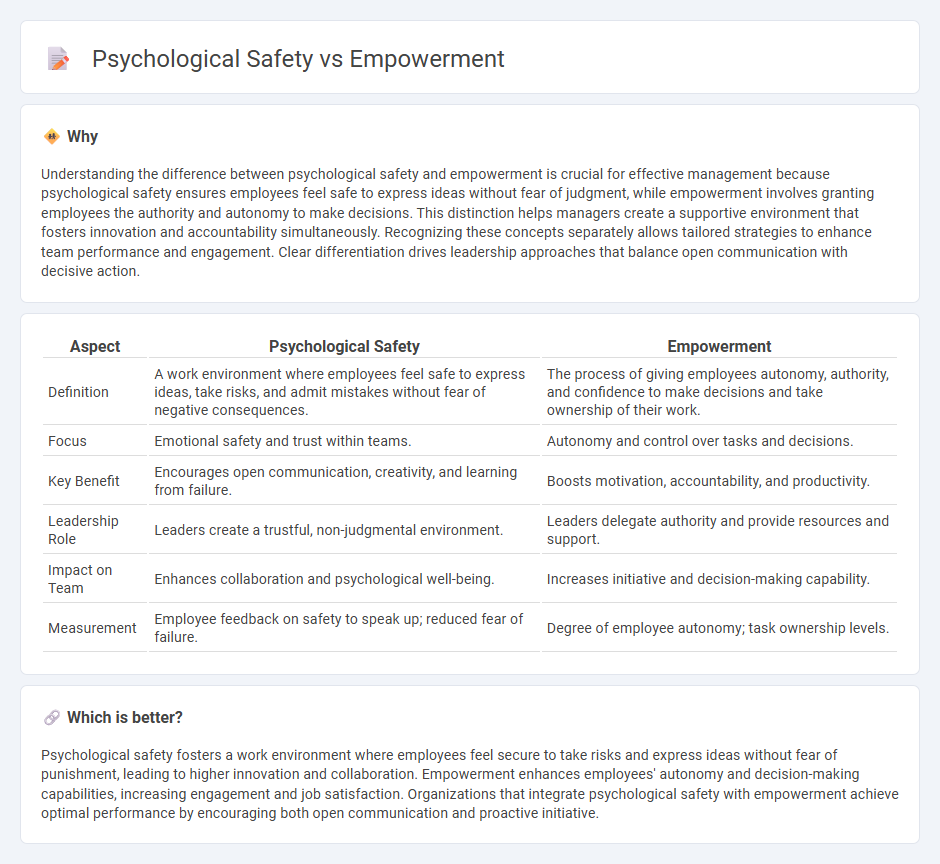
Psychological safety fosters an environment where employees feel secure to express ideas and take risks without fear of negative consequences, enhancing open communication and collaboration. Empowerment involves granting employees authority, resources, and responsibility to make decisions, driving motivation and accountability within teams. Discover more about how balancing psychological safety and empowerment can transform organizational performance.
Why it is important
Understanding the difference between psychological safety and empowerment is crucial for effective management because psychological safety ensures employees feel safe to express ideas without fear of judgment, while empowerment involves granting employees the authority and autonomy to make decisions. This distinction helps managers create a supportive environment that fosters innovation and accountability simultaneously. Recognizing these concepts separately allows tailored strategies to enhance team performance and engagement. Clear differentiation drives leadership approaches that balance open communication with decisive action.
Comparison Table
| Aspect | Psychological Safety | Empowerment |
|---|---|---|
| Definition | A work environment where employees feel safe to express ideas, take risks, and admit mistakes without fear of negative consequences. | The process of giving employees autonomy, authority, and confidence to make decisions and take ownership of their work. |
| Focus | Emotional safety and trust within teams. | Autonomy and control over tasks and decisions. |
| Key Benefit | Encourages open communication, creativity, and learning from failure. | Boosts motivation, accountability, and productivity. |
| Leadership Role | Leaders create a trustful, non-judgmental environment. | Leaders delegate authority and provide resources and support. |
| Impact on Team | Enhances collaboration and psychological well-being. | Increases initiative and decision-making capability. |
| Measurement | Employee feedback on safety to speak up; reduced fear of failure. | Degree of employee autonomy; task ownership levels. |
Which is better?
Psychological safety fosters a work environment where employees feel secure to take risks and express ideas without fear of punishment, leading to higher innovation and collaboration. Empowerment enhances employees' autonomy and decision-making capabilities, increasing engagement and job satisfaction. Organizations that integrate psychological safety with empowerment achieve optimal performance by encouraging both open communication and proactive initiative.
Connection
Psychological safety fosters an environment where employees feel secure to express ideas and take risks without fear of negative consequences, which directly enhances empowerment by encouraging autonomy and ownership of tasks. Empowered employees demonstrate higher engagement, innovation, and decision-making confidence, driven by the trust cultivated through psychological safety. This symbiotic relationship strengthens overall team performance and promotes a resilient organizational culture.
Key Terms
Autonomy
Empowerment and psychological safety both foster autonomy but differ in approach; empowerment emphasizes granting individuals control and decision-making authority, while psychological safety ensures a supportive environment where people feel safe to express ideas without fear of negative consequences. Studies show that autonomy drives motivation and innovation when combined with a culture that encourages risk-taking and open communication. Discover how balancing empowerment and psychological safety enhances workplace effectiveness and autonomy.
Trust
Empowerment and psychological safety both hinge on trust as a foundational element, with empowerment involving delegating authority and encouraging autonomy while psychological safety ensures individuals feel secure expressing ideas without fear of negative consequences. Trust fosters a supportive environment where employees confidently take risks, share innovative ideas, and engage fully, enhancing overall organizational performance. Discover how cultivating trust bridges empowerment and psychological safety to transform workplace culture.
Voice
Empowerment and psychological safety both enhance employee voice, but empowerment emphasizes autonomy and decision-making authority, while psychological safety fosters a risk-free environment for open expression. Psychological safety reduces fear of negative consequences, encouraging individuals to share ideas and concerns freely, whereas empowerment provides the confidence and resources to act on those voices effectively. Explore strategies to cultivate both empowerment and psychological safety for a thriving organizational culture.
Source and External Links
Empowerment: Definition and How To Apply It in the Workplace - Empowerment is the process of becoming more confident and prepared to make important decisions and complete tasks, often involving motivating oneself or others to take initiative and solve problems in professional settings.
Empowerment - Wikipedia - Empowerment refers to the degree of autonomy and self-determination in people and communities, enabling them to represent their interests responsibly and act with confidence in controlling their lives and claiming their rights.
EMPOWERMENT | definition in the Cambridge English Dictionary - Empowerment is the process of gaining freedom and power to do what you want or to control what happens to you.
 dowidth.com
dowidth.com